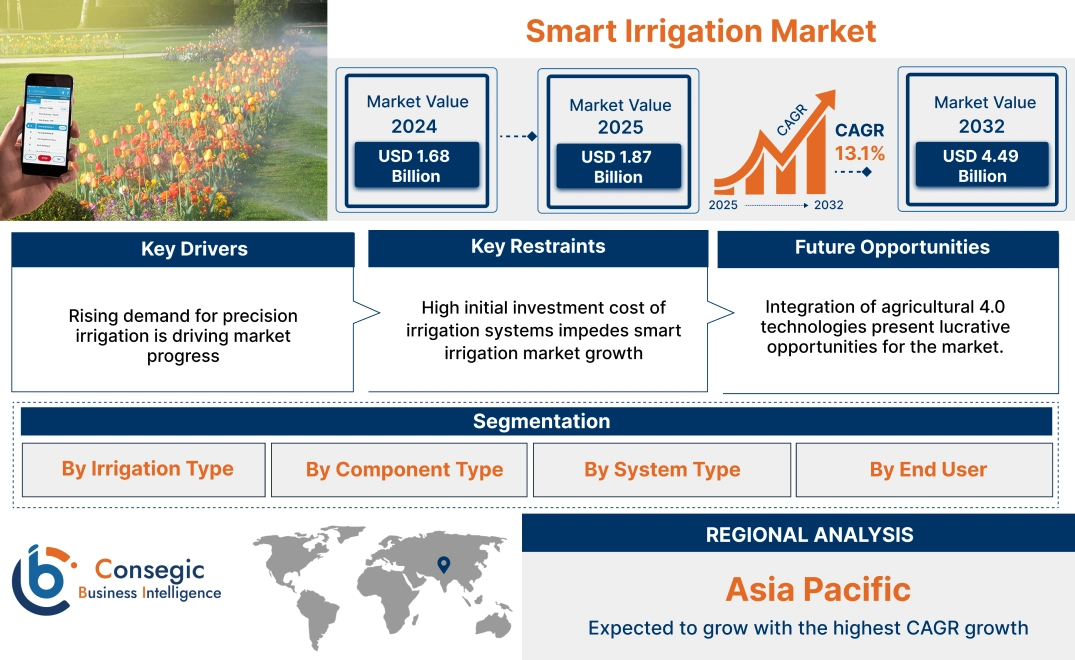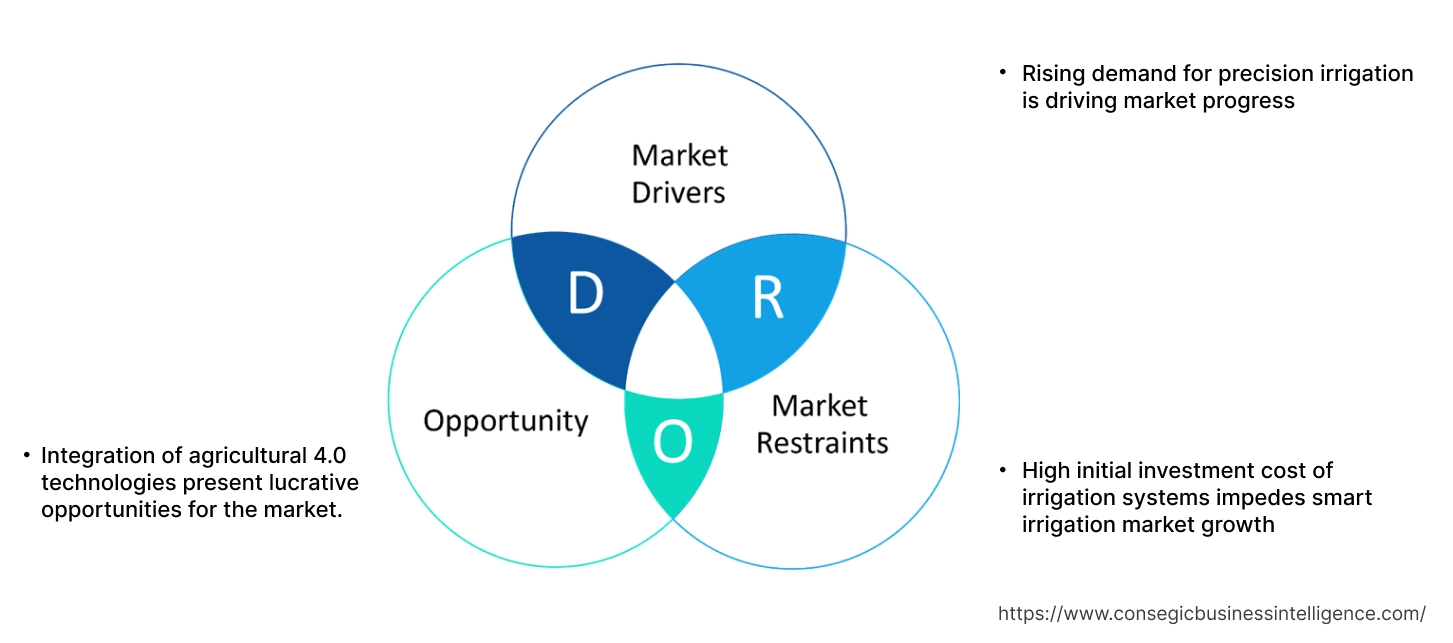- Summary
- Table Of Content
- Methodology
Smart Irrigation Market Size:
Smart Irrigation Market size is estimated to reach over USD 4.49 Billion by 2032 from a value of USD 1.68 Billion in 2024 and is projected to grow by USD 1.87 Billion in 2025, growing at a CAGR of 13.1% from 2025 to 2032.
Smart Irrigation Market Scope & Overview:
Smart irrigation is an innovative technique to reduce water wastage by using real-time monitoring to assist crops with the right amount of water based on the crop requirement. It offers extensive potential to transform farming as farmers benefit from enhanced crop yield and quality, while ensuring sustainability. It enables the user to track and optimize water usage, monitor leakages, and warn about possible issues regarding irrigation.
These irrigation systems make use of integrated sensors, controllers and IoT technology which provide automatic customized irrigation schedules and run times, based on soil and weather conditions for any crop system requirements, mainly catering to the outdoor water usage.
Furthermore, they are extensively used in the agriculture industry, sports grounds, golf courses, landscaping, residential areas, and public parks, ensuring more efficient irrigation and sustainable water and energy conservation.
Key Drivers:
Rising demand for precision irrigation is driving market progress
Precision irrigation makes use of cutting-edge technology to distribute water in small amounts. It works best in insufficiency of water, efficiently delivering optimum water and nutrients to the crops. Integrating these irrigation systems into precision irrigation assists in sustainable management and efficient soil protection by reducing runoff. It reduces water usage by analyzing data from real-time soil and weather sensors to deliver precise water control. Furthermore, it provides financial benefits to farmers by keeping the soil healthy and fertile in the long term, thereby providing better water retention and boosting crop yield.
- For instance, in February 2025, Netafim, a part of Orbia’s Precision Agriculture business group and a global leader in precision irrigation technology, launched its patented Hybrid Dripline System, the first and only dripline with a built-in welded outlet in the world. This system allows precise irrigation while eliminating labor-intensive tasks of orchards, greenhouses, and vineyards.
Thus, these factors drive the appeal for precision irrigation, fueling the smart irrigation industry.
Key Restraints:
High initial investment cost of irrigation systems impedes smart irrigation market growth
Installing a smart irrigation system includes advanced features such as intricate sensors and controllers, high-end IoT technology, and precise monitoring systems that often require high capital investment. Moreover, small-scale producers and residential landscape owners in many developing regions often lack financial resources to invest in such systems. As per market analysis, the high upfront cost of these systems limits their adoption among small and medium farmers and property owners, impeding global smart irrigation market expansion.
Future Opportunities:
Integration of agricultural 4.0 technologies present lucrative opportunities for the market.
The incorporation of agricultural 4.0 technologies like Internet of Things (IoT) technology, edge computing, AI and ML in irrigation systems will revolutionize irrigation methods in agriculture, expanding global smart irrigation market opportunities. These technologies manage irrigation precisely and effectively, predict requirements for watering crops, ensure remote and automatic control and optimize water conservation, thereby boosting smart irrigation market growth. Furthermore, construction of efficient wireless sensor networks and algorithms for advanced irrigation like predictive models, evapotranspiration (ET), and fuzzy control, will provide reliable real-time data for the overall irrigation area. These models analyze large amounts of data, accurately predict water availability and requirements, monitor the environment and provide real-time meteorological sensor data.
- For instance, in March 2024, WiseConn, a leader in precision drip irrigation solutions announced an API integration with CropX Technologies. This integration will provide efficient data collection from sensors, satellites, rain gauges and analyze it for managing crops for farmers across the globe.
Future advances in these technologies would ensure significant development in irrigation techniques, fueling the global smart irrigation market opportunities during the forecast period.
Smart Irrigation Market Segmental Analysis :
By Irrigation Type:
Based on Irrigation Type, the market is categorized into Drip Irrigation, Sprinkler Irrigation, Center Pivot Irrigation and Others.
The Drip irrigation segment holds the largest revenue of the overall smart irrigation market share of 40.7% in the year 2024.
- Drip irrigation, also known as trickle irrigation, is a type of micro irrigation that aids in delivering water and nutrients directly to the roots of plants.
- In a drip irrigation system, a pump is used to deliver water through pipes that are placed close to the soil. The emitters present on these pipes release water drop-by-drop onto the roots.
- Additionally, it reduces water wastage, optimizes water and nutrient usage, and improves plant health through effortless monitoring.
- For instance, in July 2024, Netafim France partnered with McCain Foods to apply drip irrigation for cultivating potatoes. Significant results of field trials showed that drip reduced water usage by 20% and improved crop yield by 4% to 23%.
- According to the smart irrigation market analysis, drip irrigation segment holds the largest revenue share due to its water conservation benefits, technological advancements, and growing need for high crop yields, significantly boosting the smart irrigation market demand.
The Sprinkler Irrigation segment is expected to grow at the fastest CAGR during the forecast period.
- Sprinkler irrigation is a technique to irrigate crops through a network of pipes and sprinkler heads that release water in a controlled manner.
- Additionally, it assists in conservation of water by reducing runoff, efficient distribution of water throughout the area, and is a versatile choice for a variety of soil types.
- Sprinkler irrigation is widely used in various applications like agriculture, golf courses, landscaping, residential and commercial lawns, and sports fields.
- For instance, in February 2025, Nelson Irrigation, a leader in manufacturing irrigation equipment, announced the release of the R7 Rotator, a micro sprinkler with anti-insects’ nozzle with an economic and simple mounting design.
- Therefore, the market analysis shows that, due to their ease of use, better water efficiency and uniform water distribution, reduced water wastage, and the ability to enhance plant productivity, sprinkler irrigation is anticipated to grow rapidly, driving the global smart irrigation market expansion.
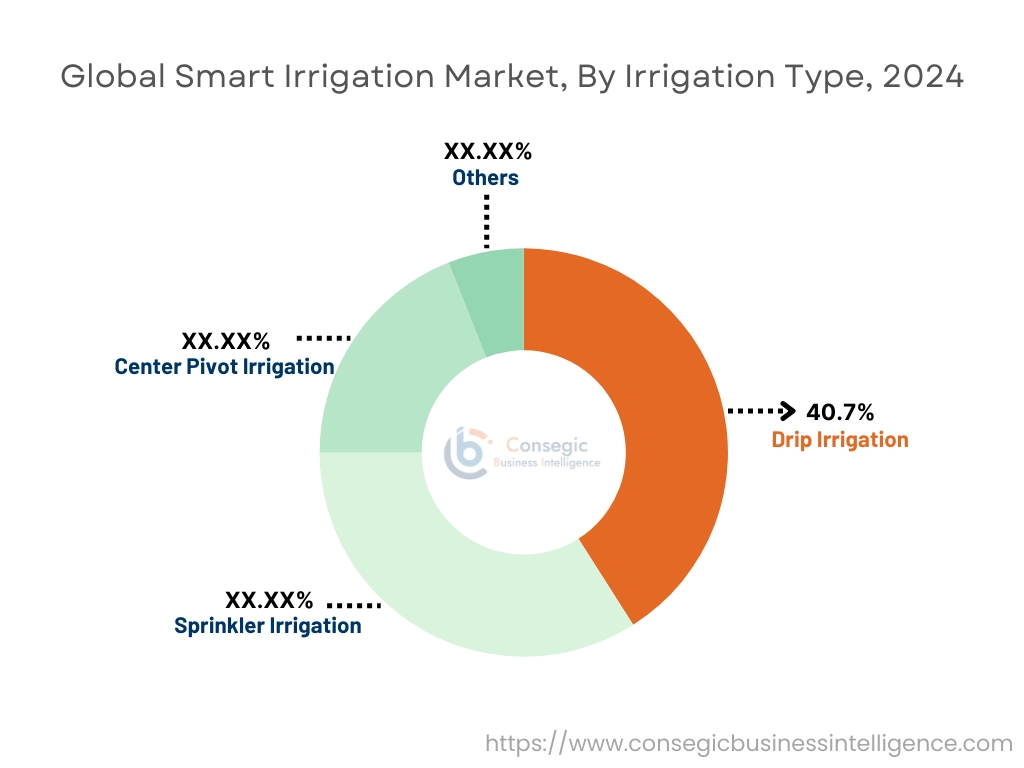
By Component Type:
Based on Component Type, the market is categorized into Hardware (Sensors, Controllers, Water Flow Meters, and Others), and Software (Irrigation Management and Control Software, Irrigation Design Software, and Others).
The Hardware segment accounted for the largest revenue share of the smart irrigation market share in the year 2024.
- The hardware segment mainly constitutes the sensors, the controllers, the water flow meters and several other parts.
- It is majorly benefited by the growing trend of cutting-edge sensor technologies and IoT-enabled devices.
- Additionally, rising demand for these irrigation systems in agricultural fields, turfs, sports ground, etc. boosts the need for hardware components, fueling the market.
- For instance, in September 2024, Irrigreen, a leading irrigation industry, launched Smart Controller 3, a unique sprinkler controller that provides controlled irrigation, enhances lawn quality and promotes water conservation.
- Based on the industry analysis, the growing trend for advanced hardware models in agricultural and commercial settings and the rising awareness for precision agriculture has significantly driven the smart irrigation market trends.
The Software segment is expected to grow at the fastest CAGR during the forecast period.
- The software system mainly gathers, sorts, analyzes, and stores data from different parts of the smart irrigation systems. It programs the watering schedules according to the needs of the plants.
- Additionally, the system can be connected to a Wi-Fi network enabling remote control of the field area with a smartphone or any other smart device.
- Furthermore, it extensively benefits the farmers, homeowners and property owners to efficiently control their irrigation schedules, saving cost for additional controllers and devices, and easy access to multiple settings.
- For instance, in May 2024, Lindsay Corporation announced upgrades to their FieldNET Advisor. This application eases irrigation decision making for farmers, improves product’s ROI, provides real-time data upgrades, and manages the complete farm.
- As per the smart irrigation market analysis, the software system segment is largely benefited by the growing advances in technology, convenience to the users, and the remote management abilities, significantly expanding the market.
By System Type:
Based on System Type, the market is categorized into Weather-based System and Sensor-based System.
Weather-based System holds the largest revenue share in the market in 2024.
- The weather-based systems, also known as the evapotranspiration (ET) systems, gather data from local weather forecasts to customize schedules for watering and enriching crops.
- Weather based controllers monitor wind speed, humidity, temperature, and solar data daily and collaborate with the data from other sensors to schedule watering run times.
- Additionally, they benefit farmers, homeowners, and businesses by reducing wastage of water and providing efficiently tailored irrigation scheduling.
- For instance, in February 2024, CropX Technologies, a world leader in smart farming technologies, launched Reinke Direct ET in partnership with Reinke Irrigation. It aids farmers in enhancing water management through Evapotranspiration (ET) measurements of the field.
- The widespread integration of weather-based systems in various agricultural and commercial settings, demand for precising agriculture and sustainable farming is fueling the market growth.
Sensor-based System is estimated to grow at the fastest CAGR during the forecast period.
- The sensor-based systems compute data gathered from sensors present below the ground to monitor soil moisture. Just like weather systems, these systems too aid in water conservation by ensuring the crop quality.
- Additionally, these systems monitor soil moisture, enable water management, and optimize watering schedules to avoid over- or under- watering of plants.
- Furthermore, the incorporation of IoT enabled smart sensors and efficient water conservation features have significantly reduced water wastage and enhanced crop yield.
- For instance, in January 2025, Hunter Industries introduced advanced features in their ICC2 Controller. It is equipped with built-in flow monitoring, quick sensors that react quickly to hydraulic issues, cloud connectivity, system augmentation and widespread control of 54 zones.
- According to the market analysis, the growing demand for sensors in drought-prone areas, technological advances, and rising awareness for sustainability is fueling the market.
By End User:
Based on End-User, the market is categorized into Agriculture (Open Farms and Greenhouses) and Non-Agriculture (Golf Courses, Turf and Landscapes, Sports Grounds, Residential areas and Others).
The agriculture segment holds the largest revenue share in the market in 2024.
- Smart irrigation systems are widely used in agriculture, including open farms and greenhouses, to establish precise farming and sustainable water management, in turn helping farmers to prepare for adverse climate changes.
- Additionally, the system assists in analyzing real-time data regarding soil moisture, weather conditions, and plant needs, providing farmers with custom watering schedules and sustainable farming methods.
- Furthermore, implementation of advanced technologies like IoT-enabled irrigation systems, smart sensors, and easy monitoring has significantly accelerated market.
- For instance, in November 2024, Netafim Italia, a subsidiary of Netafim, acquired 100% shares of Tecnir S.r.l., a leader in irrigation system design and installation, based in Faenza. This acquisition boosts Netafim Italia’s leadership in precision irrigation and provide advanced and tailored solutions to Italian farmers.
- Therefore, growing awareness, rising trend of advanced technologies, and the need for precise agriculture fuels the market to expand.
The non-agriculture segment is expected to register the fastest CAGR during the forecast period.
- The non-agriculture segment mainly includes the application of smart irrigation systems in residential areas, turfs and landscapes, golf courses, and sports grounds.
- These irrigation systems resort to real-time data, adjust watering schedules, and promote better water efficiency.
- Furthermore, investing in these intelligent irrigation systems significantly reduces maintenance and water expenses and improves the aesthetics of landscape, thereby benefiting homeowners and commercial property owners.
- For instance, in January 2023, Moen introduced a Smart Sprinkler Controller and Smart Wireless Soil Sensor. These controllers provide intelligent solutions to control irrigation systems in a household setting and the soil sensors assist controllers with accurate data on zone moisture levels.
- Based on the market analysis, these systems boost sustainable water management, landscape maintenance, and save additional costs, significantly driving the smart irrigation market trends.
Regional Analysis:
The regions covered are North America, Europe, Asia Pacific, Middle East and Africa, and Latin America.
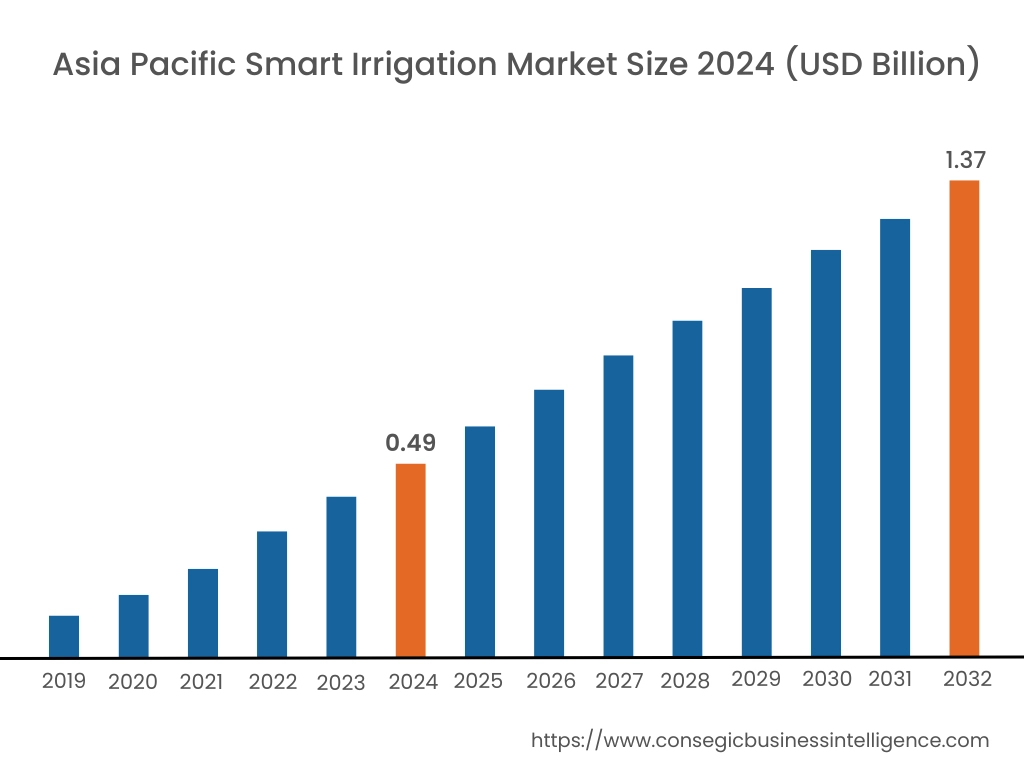
Asia Pacific region was valued at USD 0.49 Billion in 2024. Moreover, it is projected to grow by USD 0.55 Billion in 2025 and reach over USD 1.37 Billion by 2032. Out of this, China accounted for the maximum revenue share of 38.0%.
The Asia-Pacific region is greatly influenced by the dominant agricultural practices in various countries like China, India, Indonesia and Australia. Additionally, advancements in technological infrastructure, rapid urbanization, and the growing government initiatives to focus on water conservation have significantly driven the smart irrigation market demand.
- For instance, in March 2024, the Government of Japan, in collaboration with the United Nations Development Programme, inaugurated two types of polyhouses in Jajarkot. These multipurpose nursery polyhouses are equipped with drip irrigation and mist irrigation systems that assist in water conservation and increasing crop yield.
Furthermore, focus on low-cost and user-friendly irrigation devices, and sustainable farming techniques is rapidly fueling the market in this region.
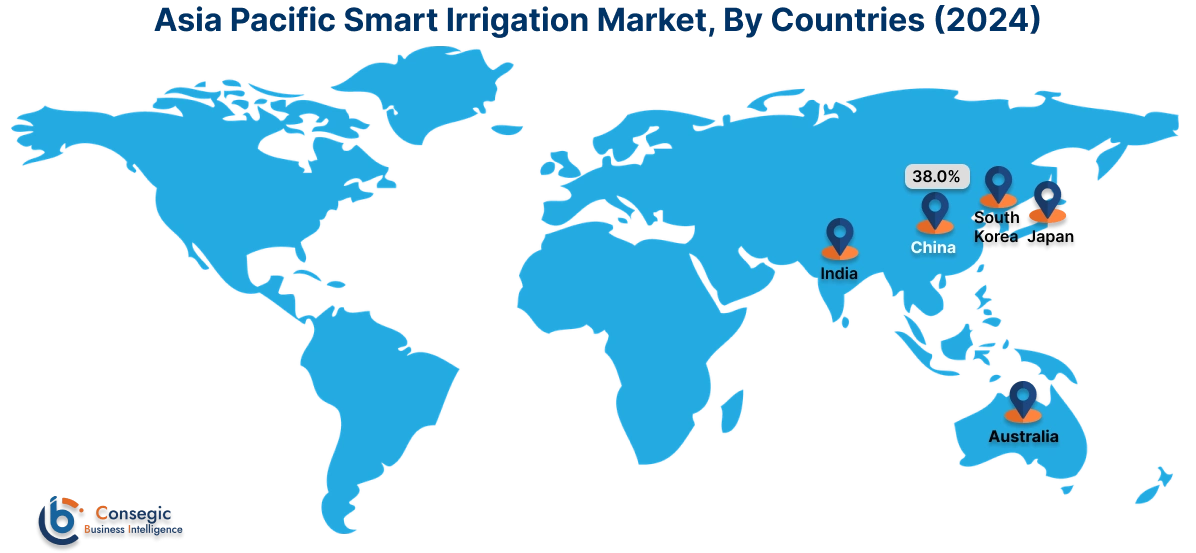
North America is estimated to reach over USD 1.45 Billion by 2032 from a value of USD 0.56 Billion in 2024 and is projected to grow by USD 0.62 Billion in 2025.
In North America, the market is influenced by the rising trend in water conservation and management. The exponential rise in technological innovations like wireless and IoT driven smart devices, and the integration of AI and ML models for efficient water tracking has further fueled the market growth.
- For instance, in April 2024, GroGuru, commercially launched the wireless soil sensor probe for consistent monitoring for the roots of annual crops. This patented wireless underground system consists of six sensors at different soil depths to measure soil’s moisture and temperature.
Furthermore, the regional analysis depicts that the increasing policies and initiatives by the government to promote sustainable development, growing agriculture and commercial landscapes and the rising trend of cutting-edge irrigation systems has driven the smart irrigation market size in this region.
Europe exhibits a strong presence in the market due to the growing state-of-the-art technologies and intelligent watering solutions. The initiatives taken by government agencies such as the Organization for Economic Co-operation and Development (OECD) to encourage water conservation through smart devices has further fueled the market growth. Additionally, increasing awareness and need for sustainable water management in agriculture driven by strict regulations aid in significant market expansion.
The smart irrigation market in the Middle East and Africa experiences steady growth mainly due to the rising awareness about water scarcity leading to adoption of more sustainable approaches. Additionally, the integration of advanced technologies such as IoT, smart sensors, and AI driven models support significant market trends. Furthermore, the increasing focus on sustainable development and water conservation have fueled market growth.
In Latin America, countries like Argentina, Mexico, and Brazil rely largely on agriculture. Growing focuses on improving agricultural productivity, sustainable farming, and water management fuel the market in this region. Furthermore, the growing technological advancements and strategies to implement intelligent irrigation solutions substantially drive the market growth.
Top Key Players & Market Share Insights:
The smart irrigation market is highly competitive with major players providing products and services to the national and international markets. Key players are adopting several strategies in research and development (R&D), product innovation, and end-user launches to hold a strong position in the global smart irrigation market. Key players in the smart irrigation industry include -
- Rain Bird Corporation (United States)
- Netafim (Israel)
- Rachio inc. (United States)
- Valmont Industries, Inc. (United States)
- Hunter Industries Inc. (United States)
Recent Industry Developments :
Product Launches:
- In January 2025, Full Nature Farms, a leading vertical farming and agritech innovation, launched Rocket 2.0 Smart Irrigation Platform. The platform delivers cutting-edge sensor technology with the integration of AI to farmers, allowing them to control water wastage.
- In September 2024, Netafim, a part of Orbia Precision Agriculture business group and a leader in global precision agriculture solutions, launched GrowSphere, a state-of-art operating system that automates precision agriculture and fertigation.
Smart Irrigation Market Report Insights:
| Report Attributes | Report Details |
| Study Timeline | 2019-2032 |
| Market Size in 2032 | USD 4.49 Billion |
| CAGR (2025-2032) | 13.1% |
| By Irrigation Type |
|
| By Component Type |
|
| By System Type |
|
| By End User |
|
| By Region |
|
| Key Players |
|
| North America | U.S. Canada Mexico |
| Europe | U.K. Germany France Spain Italy Russia Benelux Rest of Europe |
| APAC | China South Korea Japan India Australia ASEAN Rest of Asia-Pacific |
| Middle East and Africa | GCC Turkey South Africa Rest of MEA |
| LATAM | Brazil Argentina Chile Rest of LATAM |
| Report Coverage |
|
Key Questions Answered in the Report
How big is the smart irrigation market? +
Smart Irrigation Market size is estimated to reach over USD 4.49 Billion by 2032 from a value of USD 1.68 Billion in 2024 and is projected to grow by USD 1.87 Billion in 2025, growing at a CAGR of 13.1% from 2025 to 2032.
What specific segments are covered in the smart irrigation market? +
The smart irrigation market specific segments for Irrigation Type, Component Type, System Type, End-user, and Region.
Which is the fastest-growing region in the smart irrigation market? +
Asia pacific is the fastest growing region in the smart irrigation market, with countries like China and India experiencing rapid development.
What are the major players in the smart irrigation market? +
The key players in the smart irrigation market are Rain Bird Corporation (United States), Netafim (Israel), Rachio inc. (United States), Valmont Industries, Inc. (United States), Hunter Industries Inc. (United States), Irrigreen (United States), AquaSpy (United States), Green Electronics LLC (Egypt), WiseConn Engineering (United States) Reinke Manufacturing Co., Inc. (United States), and others.
